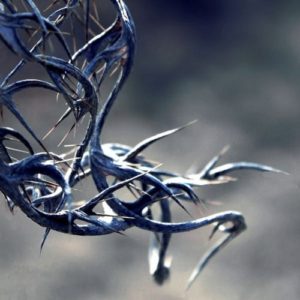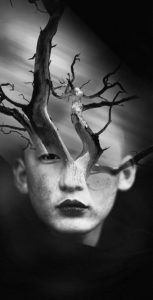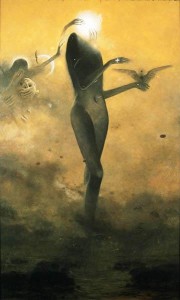Type 4 ~ The Thornbirds
Type 4 ~ The Thornbirds
According to G. I. Gurdjieff, who introduced the enneagram symbol to the western world, you could draw “the enneagram in the sand, and in it read the eternal laws of the universe.”
And each subsequent time you drew the symbol, you could “learn something new, something [you] did not know before.”
There’s been much chatter in recent years, including my own, about the nature of Type 4 especially, partly due to how common it is for people to self-type as 4s more than any other type, it seems. Some well-renowned enneagram authors have speculated that as many as two-thirds of the people self-typing as 4 may be incorrect in their self-assessment. And because of the ubiquity of this phenomenon, the definition and overall sense of ‘what 4 is’ has drifted, loosened, been swirled in with other Types.
So, pinging off of Gurdjieff’s quote above, my proposition is: Let’s let the enneagram symbol itself tell us about 4.
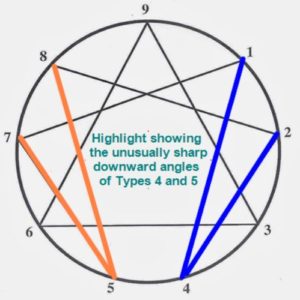
Per the graphic above, there are no other two types besides 4 and 5 that have such sharp angles. This symbolizes specificity, exclusion, dismissing or figuratively pushing oneself away from ‘all the rest’ – in some sense this is an over-particularizing of the self.
Looking strictly at the geometry of the symbol, Types 8, 9, 1, 3, and 6 all form equilateral triangles via their connecting lines. Types 2 and 7 each have an angle that is wider, more open, than any of the other types. Considering Type 4, if you ran a line between Points 1 and 2, to form a triangle, in comparison to the other triangles, 4 is a radical distortion, an acute and unusual state of being.
The angles coming in at Points 4 and 5 are the least open, the least reflexively embracing. In contrast to the hashtag #allthefeels, this is the exact opposite – a narrow set of feels (and thinks). No other connecting lines on the ennea-symbol are so (symbolically) self-condensing as these two.
So, a special characteristic of 4 is its capacity and reflex to reject, dismiss, separate oneself from the commonality of others and most of the world. This theme of differentiation continues as we notice 4 and 5 puncturing through the ground-level horizon line that connects 3 and 6, burrowing downward and contracting into more and more specificity and refinement. Piercing into the underworld of self, at specific inner points, down a thinning tunnel designed for one – a self-dive away from the sunlit collective of ‘the everyday.’ “I am not like them.” In various ways, 4 and 5 amputate themselves away from alignment with the World.
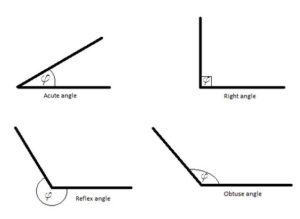
Again, this subterranean realm (below Earth’s horizon line at 6—3) – unique to Points 4 and 5 – represents the earthy psychic flesh of ‘the self,’ the individual plunging his/her own self-involved subjective interior pathway.
This is the self-absorption spoken of in the Type 4 descriptions. And here, in the symbol, we see that this characteristic of 4 is structural. Being unlike others is how the 4 type structure is aligned (literally ~ the lines). This isn’t a sad fact about 4 – it’s their preference and design.
The above is all intended to be describing a deep internal form and pattern, not meant to suggest that 4s aren’t active in the world; it implies a preference to conceive of oneself as separate, different, rare, an undiscovered carefully excavated archeological artifact.
4s are at home (and prefer) moving around in the world in a state of dissimilarity to others. In fact, as an image type, 4s are looking to be seen (in the world) as the different unusual person envisioned in their self-concept.
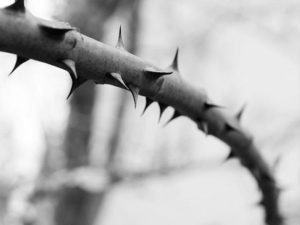
And per the thorny nature of the 4 Point, 4s prefer some amount of putting people on edge, often sharply provoking with their hyper-distinctions. This interactive style continually draws a further line of self-differentiation in relation to others. It also exposes where others ‘are at’ as they react to the 4’s provocations, which is a Reactive type reflex. 4, 6, and 8 are compelled to ‘get at truth’ in the moment and tend to not believe that ‘reality’ has shown itself unless what’s revealed includes something negative, something uncovering an aspect of the hidden underbelly of the person or circumstance at hand.
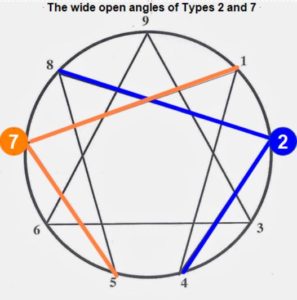
As an illustrative point of comparison, these qualities about 4 and 5 are emphasized further when we again consider the symbolic geometry of Types 2 and 7, the two types with the widest, most open angles on the ennea-symbol.
Type 2’s movement to 4 and Type 7’s movement to 5 represent ‘a correction’ which can take 2 and 7 into the submerged subterranean parts of themselves. 2 is then allowing themselves to steep in their own overt self-absorption and is seeing into the truth of the dark parts of their heart via the cutting specificity of 4.
And 7 at 5 is saturating, sinking, lingering long in a given singular experience or particular point of mental fascination, as opposed to skimming or reflexively jumping out of whatever ‘hole’ they’re searching down into.

As all of this discussion of angles and lines indicates – and if I haven’t said the word enough times yet – the Enneagram Types are actual psychic structures, as opposed to lists of traits or descriptions of motivations, fears, qualities.
So, in the enneagram symbol itself, 4 can be seen for what it is: a harsh and alienating outline, ‘difficult’ and dismissing or not attuning to everyone else’s angle (perspective) on things. 4 is barbed and intricate, self-incestuous, self-penetrating.
Look at the action of the lines going from Points 1 and 2 down into 4: ever tapering and self-distilling into self-specificity, painting oneself into a sharp corner of dissimilarity. And as it is with all of the Types, the 4 superego is unconsciously urging: “This is what I should be doing.”
